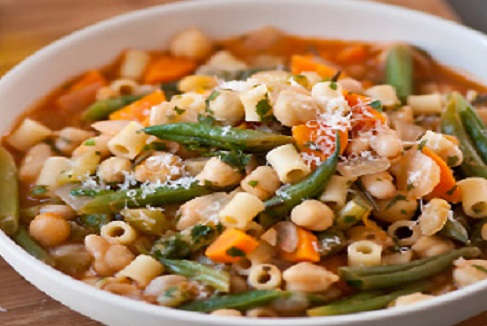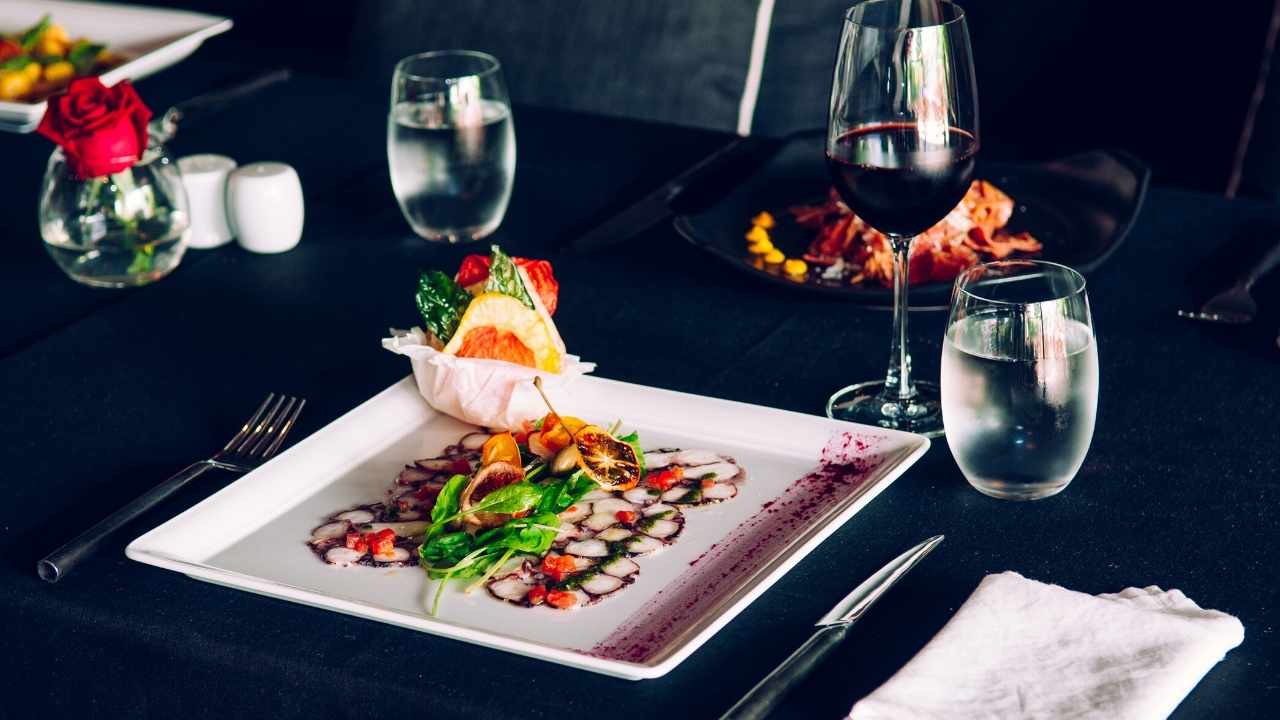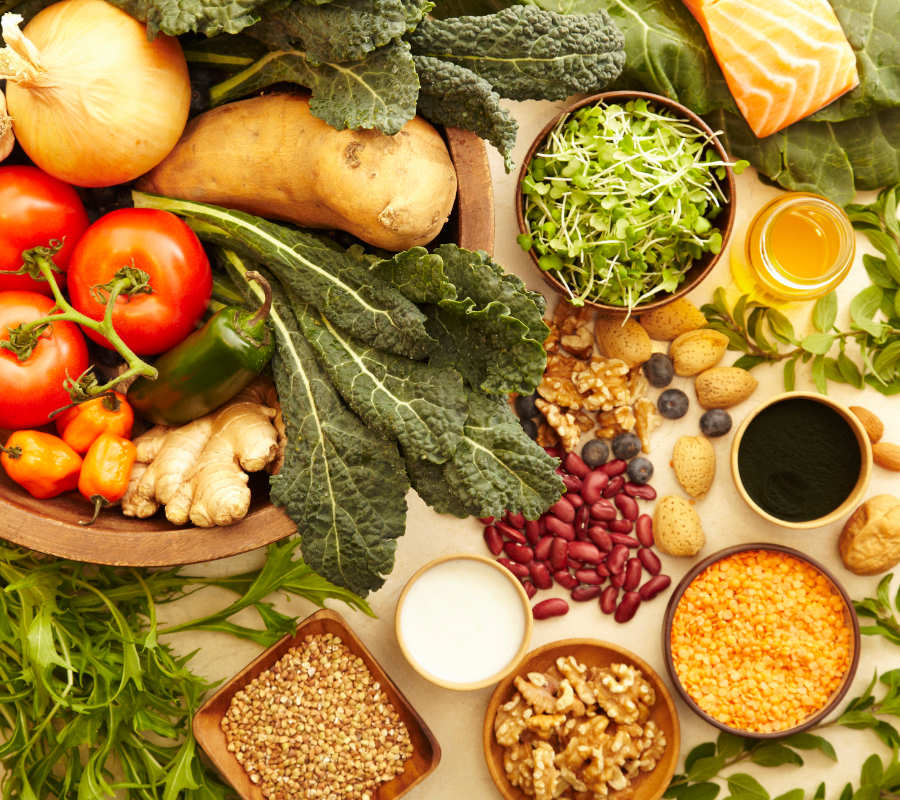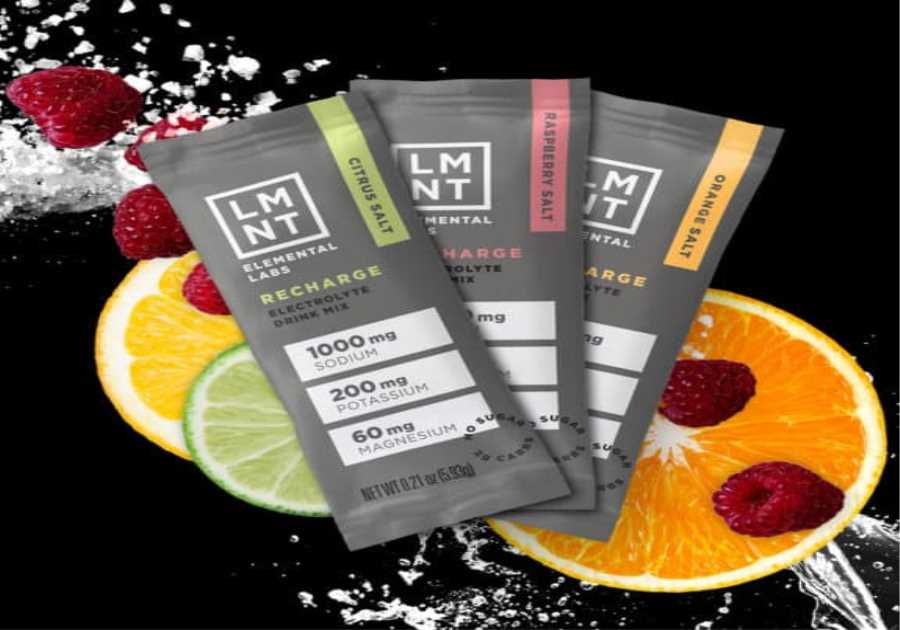
Romano beans are a form of flat snap bean which originated in Italy. Specialty grocers and farmers’ markets sometimes carry them and they can also be grown at home, assuming you live in an area with a Mediterranean climate. They are usually available in late summer and fall. They are also readily available frozen in most markets.
Like other snap beans, Romano beans are supposed to be eaten whole. They are considered ripe when they make a crisp “snap” if they are broken in half, and they have a very mild flavor and a tender texture. These beans are often braised with other vegetables and eaten as a side dish. They can also be added to soups, stews, stir fries and an assortment of other dishes. These beans can also be pickled.
You may also hear these legumes referred to as Italian flat beans or Italian snap beans, but don’t confuse them with fava beans, which are sometimes labeled as “Italian broad beans.” These snap beans are flattened, rather than rounded, as one might expect. To use Romano beans, snap or trim off the ends and rinse the pods to remove any dirt from the field. These beans can be lightly cooked to retain their crunchy texture or cooked until they are extremely tender. However, overcooking will cause the beans to turn into a tasteless mush, so take care when preparing them in braised and other long-cooked dishes.
In addition to being available in classic green, Romanos also come in yellow and purple, for cooks who like to play around with different colors in their cooking. When selecting Romano beans in the market, look for crisp specimens with even coloration and no soft spots or signs of mold. Limp, listless beans should be avoided and the beans should be stored in paper bags and used within a few days for best results.
How to Steam
Step 1
Rinse Romano beans under running water to wash away any debris. Drain the beans in a colander.
Step 2
Set a steamer basket in a large cooking pot with 1 inch of water in the bottom. Turn the heat to high, and bring the water to a boil.
Step 3
Chop the stem and tips of the beans off with a sharp paring knife while the water is heating. Cut the beans into 1- to 1 1/2-inch sections. For an attractive visual effect, hold the knife at a 45-degree angle to the beans, to cut sections on the diagonal.
Step 4
Place the bean pieces in the steamer basket. Set the lid on the pot, and cook for three to four minutes.
Step 5
Remove the lid, and test the beans tenderness with the tip of a sharp knife. If the beans are not yet soft, use a spoon to rotate the pieces at the top of the steamer basket to the bottom, nearer the water. Cover with the lid, and cook for another two to three minutes.
Step 6
Drain the beans in a colander and serve immediately, seasoned with salt or salt substitute and fresh-ground black pepper to taste.
How to Boil
Step 1
Fill a large pot half full of water, add 1 to 2 tsp. salt, and cover the pot with a lid. Bring the water to a full, rolling boil over high heat.
Step 2
Add washed Romano beans that have been cut into 1- to 2-inch pieces to the pot of boiling water.
Step 3
Boil bean pieces until tender. Remove the bean pieces from the pot with a slotted spoon, and serve promptly.
How to Braise
Step 1
Cook onions, celery, carrots or any other garnish or vegetable you prefer, in olive oil over medium heat until golden.
Step 2
Add additional flavorings such as tomatoes or minced garlic, then add cut Romano beans. Add seasonings of your choice to taste.
Step 3
Simmer over medium-low heat for 40 to 50 minutes, stirring occasionally, until the beans are soft and most of the moisture has evaporated. Cool your braised Romano beans for five to 10 minutes before serving.
Tips
- If you are using the steamed beans in a cold salad recipe, place the drained beans in a large bowl filled with cold water and ice. Allow the beans to cool completely before draining in a colander.
- If you have both small and large beans to cook, separate them into two batches for cooking because the thicker ones take longer to become tender.
- Add cooked garbanzo beans or potatoes to braised Romano beans to make a hearty entrée.
Sautéed Romano Beans
Servings: 4
Ingredients
- 1 pound Romano beans
- 3 tablespoons olive oil, divided
- 2 tablespoons minced shallots
- 2 cloves garlic, minced
- 1/4 cup loosely packed fresh oregano leaves
- 3/4 teaspoon salt
- Freshly ground black pepper
- 1/2 cup cherry or grape tomatoes
- 1/2 teaspoon balsamic vinegar
Directions
Rinse the beans under cold running water. Drain, leaving any water clinging to the beans. Trim the ends and set aside.
In a large skillet, heat 2 tablespoons of the olive oil. Add the shallots and sauté over medium heat about 1 minute. Add the garlic and continue to sauté for 30 to 45 seconds, until tender and fragrant but not browned. Remove the sautéed shallots and garlic from the pan with a slotted spoon, pressing any excess oil back into the skillet. Set aside.
Add the remaining 1 tablespoon oil to the skillet. Once the oil is hot, add the beans, oregano leaves, salt and pepper to taste. Sauté over medium heat, stirring frequently until the beans are browned in spots and tender but retain some crispness, about 10 to 12 minutes. Stir in the tomatoes and cook 2 minutes. Stir in the sautéed shallots and garlic. Cook just until aromatic, about 30 seconds.
Remove the pan from heat and let the beans cool slightly. Stir in the balsamic vinegar and allow contents to cool to room temperature. Remove the salad from the pan to a serving platter.

Braised Romano Beans
Ingredients
- 1/2 cup extra virgin olive oil
- 1/2 cup minced celery
- 1/2 cup minced carrot
- 1 cup minced red onion
- 1 clove garlic, crushed
- 2 sprigs fresh rosemary
- 1 teaspoon tomato paste
- 1 cup canned crushed Italian tomatoes
- Salt and freshly ground black pepper
- 1 1/2 pounds romano beans (flat green beans), ends trimmed
Directions
Heat oil in a deep skillet or a shallow three-quart saucepan. Add celery, carrot and onion and cook over medium heat, stirring occasionally, until vegetables barely begin to brown, about 25 minutes. Add garlic and rosemary and cook until fragrant, a few minutes. Stir in tomato paste and tomatoes. Bring to a simmer. Season with salt and pepper. Simmer until mixture is well combined, about 5 minutes.
Add beans, setting them in pan all in one direction. Add 1/2 cup water. Bring to a simmer. Baste beans, season with salt, reduce heat to low. Cook gently, partly covered, turning beans in sauce from time to time, until beans are very tender, about 40 minutes. Adjust seasoning and serve hot or at room temperature.
Yield: 6 servings.

Romano Bean Vegetable Soup
Ingredients
- 1 tablespoon olive oil
- 1 chopped onion
- 2 minced cloves of garlic
- 2 chopped celery stalks
- 2 chopped carrots
- 5 cups chicken stock
- 1 cup water
- 1 can (28 oz) diced plum tomatoes
- ½ teaspoon dried oregano
- 3/4 cup small pasta, cooked
- 16 oz frozen romano beans, partially defrosted
- 1 (15-ounce) can chickpeas, drained and rinsed
- 1/4 teaspoon each salt and pepper
- Grated Parmesan cheese
Directions
In large saucepan or Dutch oven, heat oil over medium heat; cook onion, garlic, celery and carrots, stirring often, until onion is softened, about 5 minutes.
Stir in stock, water, oregano and tomatoes bring to boil. Reduce heat and simmer until vegetables are tender, about 30 minutes.
Cook pasta in boiling salted water until al dente. Drain. Add pasta, chickpeas, romano beans, salt and pepper to the soup and cook until the beans are heated.
Serve sprinkled with Parmesan cheese.

Braised Chicken With Romano Beans
Ingredients
- 4 chicken thighs, trimmed
- 1/4 cup flour
- 1 tablespoon olive oil
- 1/3 cup dry red wine
- 1/2 lb romano beans (You can also use frozen)
- 3 garlic cloves
- 1 (14 1/2 ounce) cans chopped tomatoes
- 1/2 teaspoon red pepper flakes
- 1 teaspoon fresh rosemary
- 1/3 cup kalamata olive, sliced in quarters
- Salt and pepper
Directions
Heat olive oil in a pan that has a cover. Trim the chicken thighs of extra fat, cut in half if possible, and season with salt and pepper.
Lightly dust the chicken with flour and fry over medium high heat until well browned, but not too much. Any burning is very apparent in the dish, so keep it brown, not black. Turn and finish browning.
Deglaze pan with the wine until most of the liquid is gone.
Trim Romano beans and cut on the diagonal into 1 1/2 inch pieces. Toss into pan and stir to get the cooking going. After a couple of minutes, toss in the peeled and crushed garlic. Stir another 2 minutes being careful not to burn the garlic.
Add the tomatoes and juices to the pan along with the rosemary, garlic, and additional salt and pepper as desired.
Bring to a simmer and reduce heat. Cover the pan, but leave the lid slightly ajar. Allow to cook on low heat (keep a simmer going) for 20 minutes.
Add the olives and cook an additional five minutes.

Italian Green Bean and Meatball Stew
Ingredients
- 2 tablespoons olive oil
- 1 large onion, coarsely chopped
- 3 pounds ground beef or turkey
- 1 cup seasoned Italian breadcrumbs
- 1/4 cup freshly grated Parmesan, plus extra for topping
- 1 bunch parsley, stemmed and finely chopped
- 2 eggs
- 3 cans (28 ounces each) Italian peeled tomatoes, crushed
- 2 1/2 cups chicken stock
- 1/2 teaspoon sea salt
- 1/4 teaspoon crushed red pepper
- 4 pounds small red potatoes, skin on, cut into 1-inch pieces
- 3 pounds Italian green beans, cut into 1 1/2-inch pieces
Directions
Heat oven to 400 degrees F
Meanwhile, in a large bowl, mix the meat with the breadcrumbs, Parmesan, parsley and eggs. With clean hands, work the mixture well. Shape it into 1 inch meatballs and place on greased baking sheets. Bake for 20 minutes or until brown and cooked through.
In a soup pot, heat the oil and cook the onion, stirring often, for 10 minutes or until it begins to brown. Add the tomatoes and chicken stock. Stir well. Cook over medium heat until the mixture comes to a simmer. Add salt and red pepper. Add the potatoes and simmer for 10 minutes or until tender.
Add the green beans and the meatballs. With the back of a ladle, gently press the meatballs into the liquid so they’re just submerged. Try not to break the potatoes or meatballs. Cover and simmer gently for 1 hour. Serve with shaved parmesan cheese over the top.
By: Jovina CoughlinTitle: How To Cook Italian Green (Romano) Beans
Sourced From: jovinacooksitalian.com/2014/11/03/how-to-cook-italian-green-romano-beans/
Published Date: Mon, 03 Nov 2014 14:04:52 +0000
Frequently Asked Questions
What are the basic principles of the Mediterranean diet?
Mediterranean lifestyle is known for its emphasis on healthy and nutritious food choices, regular exercise, and regular socializing. This diet emphasizes fruits and vegetables, whole grains and legumes, as well as healthy fats like olive oil and nuts. There is also a moderate amount of dairy products, fish and meat. It encourages moderate consumption of red wines. The following are the main principles of the Mediterranean Diet:
- Eat mainly plant-based meals, including fruits, vegetables, whole grain bread and cereals, beans and legumes, nuts and seeds, and healthy fats such as olive oil and other olive oils. Also, eat small amounts yogurt (preferably notfat), low-fat cheese, yogurt, and minimal amounts of red and lean meats or poultry about once a week.
- When possible, prefer fresh ingredients to pre-packaged processed foods.
- To enhance the flavor of your meals, add herbs to replace salt.
- You can incorporate physical activity into your day, such as going for a walk after dinner and taking part in a class.
- Enjoy sharing meals with friends and family, and enjoy the joy of eating together.
- Mindful eating is about paying attention to the flavors, textures, smells, and textures of your food. This will help you recognize when you are full and satisfied.
Is Banana permissible in the Mediterranean diet
Yes, bananas are allowed in the Mediterranean diet. Bananas, a nutritious, low-calorie fruit, can provide beneficial dietary fibre, potassium, vitamin B6. Bananas can be added to salads, porridge, smoothies, and sweet potato dishes as a healthy side dish. It could also be enjoyed as a snack with nut butter such as almond or peanut for added proteins. It may be beneficial to combine fruits like bananas with healthy fats such as nuts and seeds when following the Mediterranean diet. This will improve digestion and increase satisfaction while eating throughout the day.
Is it okay to eat milk on the Mediterranean diet
Yes, milk can be consumed on the Mediterranean diet. Low-fat yogurt and low-fat cheese are important components of the Mediterranean diet. They provide calcium and other essential nutrients. Also, milk is nutritious and should be included in moderation in your daily drink routine. You can also make your own smoothies or oatmeal with it. To promote sustainable farming, choose organic milk whenever possible. To ensure a balanced start, you can add milk into breakfast items such as avocado toast or smoothies.
Statistics
- The Mediterranean Diet group had a 30% lower relative risk of cardiovascular events compared to the low-fat diet group. (my.clevelandclinic.org)
- The research suggested that the diet reduced the risk of cardiovascular issues, including stroke, heart attack, and death, by about 30 percent compared with the control group. (medicalnewstoday.com)
- Choose fat-free or 1% milk, yogurt, and cottage cheese. (my.clevelandclinic.org)
- Benefits of Replacing foods high in saturated fats (like butter) with plant sources high in monounsaturated fatty acids, like olive oil, may help lower the risk of heart disease by 19 percent, according to research. (everydayhealth.com)
External Links
[TAG27]
- Mediterranean Diet Beginner's Guide: Ranked #1 Best Diet in 2023 | U.S. News
- Best Diets Overall 2023 - Expertly Reviewed - US News Health
[TAG30]
- Health Benefits of the Mediterranean Diet: Metabolic and Molecular Mechanisms - PubMed
- PubMed: Cardiovascular Health and The Mediterranean Diet - PubMed
[TAG33]
- (PDF) The Association Between Dietary Patterns And Insulin Resistance: A Systematic Study
- (PDF) Citrus as part of the Mediterranean diet
[TAG36]
How To
How the Mediterranean diet can help you lose weight while feeling great
The Mediterranean Diet emphasizes healthy fats and whole grains, legumes and fresh fruits and veggies. It has been shown that it can have numerous health benefits including lower blood lipids, improved glucose management, reduced risk for certain types of cancer and depression, better cardiac and cognitive function, and better weight management. Adopting a Mediterranean diet can be made simpler with some tips. Start by switching high-calorie snack foods like chips to nutrient-dense veggies. Learn how spices and other vegetable-derived ingredients can be used to enhance your diet. Integrate grains, legumes, and high-fiber items to increase satiety after meals. This will make it easier to enjoy food, as well as help you live a healthier life and possibly reap additional health benefits like a longer and more fulfilling life.
Resources:
 |
[TAG38]Healthline ranked the Mediterranean Diet number 1 for the following reasons: Numerous studies associate the Mediterranean diet with a reduced risk of heart |
 |
[TAG39]The Mediterranean diet originates in the food cultures of ancient civilizations which developed around the Mediterranean Basin and is based on the regular |
 |
[TAG40]Psychology Today reports: Eating more green, leafy vegetables and less red meat were associated with improved cognitive functioning in a recent study of older |
 |
[TAG41]This review of five human studies on the Mediterranean diet examines its effects on weight loss, various diseases, and the risk of death. |
 |
[TAG42]CNBC reports that Joan Salge Blake, Boston University’s clinical professor of nutrition says: “‘Poor protein [intake] can contribute to fatigue, and that’s the |
 |
[TAG43]The Mediterranean diet has been linked to a number of health benefits, including reduced mortality risk and lower incidence of cardiovascular disease. |
 |
[TAG44]According to Olive Oil Times: The authors of the meta-study, published in Current Obesity Reports, noted that hypertension, type 2 diabetes mellitus, several |
 |
[TAG45]The Mediterranean diet, with its emphasis on fresh vegetables and fruit, whole grains, legumes, olive oil and fish, provides an array of health benefits, |
 |
[TAG46]The study described in The Epoch Times found: In the conclusions of this study, the authors prefer the Mediterranean diet over the Keto diet because the key to |
 |
[TAG47]The Mediterranean diet is a heart-healthy eating plan that emphasizes healthy fats, whole grains, fruits, vegetables, beans, nuts and seeds. |
 |
[TAG48]Abstract. Consuming a Mediterranean diet rich in minimally processed plant foods has been associated with a reduced risk of developing multiple chronic diseases |
 |
[TAG49]It’s an easy (and delicious!) change that can turn your diet into a disease-fighting tool. |
 |
[TAG50]There are many misconceptions about the Mediterranean diet. Learn what it really means and how it can help you live a healthier, longer life. |
 |
[TAG51]A review article published in the journal Experimental Gerontology describes the utility of Mediterranean diet (MedDiet) in the prevention and management of |







